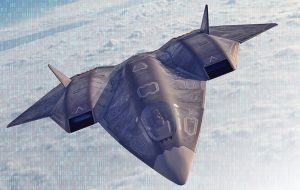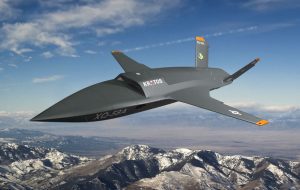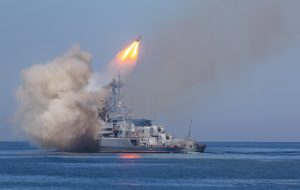Would space become an arena for military conflict among major powers in the coming years? This is a question repeatedly raised by observers and specialists as they observe this dangerous rush towards the militarization of space and the competition to control it, especially by the US and China. In addition to the accelerated developments in the field of space weaponry.
The US move to build an independent space force within the various ranks of the US Armed Forces represents an important milestone in such field. It will prompt many other powers, most notably China and Russia, to strengthen their space programs, and will spur other world powers to break into this field soberly in the near future.
Turning Fantasy into Reality… Space is a Battlefield
According to German General and famed military theorist Carl von Clausewitz (1780-1831 AD), war is more like a “chameleon”, in reference to the shifts in its nature, weapons, and the fields in which it is fought. Therefore, wars have gone through many stages or generations, according to military experts, the first of which was characterized by huge mobilization of forces and face-to-face confrontations. The second generation was much more dependent on firepower than on mobilization of scores of soldiers. The third generation was characterized by the great development of armored vehicles, greater reliance on air forces, quick movement, and the element of surprise. Finally, the fourth generation was marked by destroying the enemy from within through stirring up unrests and rebellion, and encouraging civil, sectarian, and ethnic wars, among others.
Space wars represents the fifth generation, in addition to cyber, economic, environmental, and other wars.
In 2009, an important book by George Friedman entitled “The Next 100 Years,” released, in which he predicted the intensification of space wars. Friedman argued that the political and military control of Earth will take place through space.
US Chief of Staff of the Air Force, General David Lee Goldfein, noted that it is a matter of time for the US to start fighting in outer space. This requires a re-thinking of all the military theories known in the specialized academies, and a radical review of the concept of war and its theories in the whole world.
Why the frantic race towards the militarization of space?
Recent years saw a heated race towards space militarization. Estimates indicated that such a race will become even more heated during the forthcoming period, especially in light of two main considerations:
• First: the lack of a legal framework governing this issue or preventing a space arms race, especially that both the 1963 Nuclear Test-Ban Treaty and the 1967 Outer Space Treaty are circumvented by these major powers. Meanwhile, the US rejects Russian and Chinese proposals regarding an international treaty to prevent the deployment of weapons in space, considering that such an issue cannot be verified in practice. Moreover, the Outer Space Treaty prohibits only the placement of nuclear weapons and weapons of mass destruction in outer space, but not the militarization of outer space using other non-nuclear conventional weapons.
• Second: The race for space wealth, reportedly, estimated by trillions of dollars. Harvesting these riches is invaluable. A notable example is asteroid UW158, which is a few million kilometers away from Earth and has about $5.4 trillion worth of platinum.”
Reports indicate that NASA is planning to launch small space crafts to search for minerals between dust and rocks and in asteroids floating through the solar system.
Manifestations of Space
Militarization
The most important manifestations of the race towards space militarization can be shown as follows:
First: The United States of America
In January 2019, US President Donald Trump unveiled a revised US missile defence strategy. It recommended, “deploying weapons in space which may be capable of shooting down enemy missiles.” The strategy also calls for investments in deploying space sensors that can better monitor and track incoming missiles and possibly a speed technology that exceeds the speed of sound.
It is a known fact that US interest in space dates backs decades ago. In this context, Project Excalibur, executed by the Lawrence Livermore National Laboratory (LLNL), California in the 1970s, was aimed at detonating a nuclear weapon in space by focusing X-ray radiation. However, it remained uncertain whether this project had succeeded.
There are many reasons why the US is keenly interested in space wars, most notably:
1 The US huge concern about the progress made, in particular, by China and Russia in space weapons, which threatens the dominance of Washington in space and undermines its strategic interests. . In August 2019, Deputy Assistant Secretary of Defence for Space Policy Stephen L. Kitay said that, “In China and Russia, it is widely believed that space is a weakness for the US, giving them a relative advantage over it”.
The US is concerned about the so-called “hypersonic weapons” weapons, Congress has therefore asked the Pentagon to develop and deploy space sensors that can detect and track such weapons.
China, in particular, is aware of the fact that the US is zeroing in on it by building its own space force. That is why China responded furiously after President Donald Trump approved the Military Budget Act 2020
The same concerns were voiced by Russia as President Vladimir Putin said that the US military and political leadership considers outer space a theater of military operations.
Perhaps of great concern for the US is the approaching military cooperation in space between Russia and China. Russian Sputnik website quoted a source in the Russian missile and space industry in March 2020 as saying: “China and Russia are considering the possibility of cooperation in establishing a common base on the Moon.”
2 Seeking to invest in space resources, especially the Moon and Mars, and provide military protection for the US projects. On April 6, 2020, US President Trump signed a document titled: Encouraging International Support for the Recovery and Use of Space Resources, to open the way for the US to exploit space resources under the protection of the US Space Force. Meanwhile, NASA announced “Artemis”, a program that aims to take the US back to the moon no later than 2024 instead of 2028.
Second: China
China is moving vigorously toward space, allocating substantial investments for such purpose. Experts suggest that “outer space is an integral part of China’s President, Xi Jinping’s dream to further China’s influence and power”. China’s strategy has several bases or stages: First, building a low-cost space capability for launching and reaching space. Second, building its own permanent space station. Third, building the capability to control the lunar distance. Fourth, developing potentials for permanent presence based on the establishment of local industry on the moon, as well as space-based solar power to operate and guarantee permanent human presence on the lunar station. Fifth, developing necessary capabilities for deep space exploration, and mining asteroid resources.
In this context, Beijing launched 39 rockets into space in 2018, compared to 31 by Washington, 20 by Russia, and only 8 by Europe. In 2007, China also managed to destroy one of its own satellites using a space missile launched from earth. In 2019, it sent a probe to the dark side of the moon, for the first time in history of space exploration, and is planning to build an orbiting station in the next decade. China’s expenditure on civilian and military space programs exceeds that of Russia and Japan. In May 2020, China launched the “Long March-5B” space rocket carrying a trial version of a new generation of Chinese manned spacecraft and a retrievable cargo capsule for testing in space, making China the third country after Russia and the United States to send astronauts to space using rockets.
Additionally, China is working toward upgrading “Long March 9” rocket for a trial test in 2030, which aims to launch space-based solar energy satellites into permanent geographical orbits in 2030. On the other hand, the launching of “Shenzhou 7” aims to survey the moon’s South Pole in 2030, while “Shenzhou 8” will be utilized to test basic technologies such as 3D printing.
China is also considered the first country in the world to build a plant for solar-powered satellite stations in Chongqing’s district of Bishan. It also invests in building nuclear-powered spacecrafts for testing in 2040.
Studies enumerates several reasons behind China’s strong interest in investing in space weapons, notably:
1 Enhancing strategic deterrence against external threats, especially the US ones. In this respect, Chinese military documentations indicate that “developing military space forces contributes to boosting [China’s] strategic deterrence capability”.
2 Aborting the US efforts to neutralize China’s strategic nuclear deterrence or to interfere in its internal affairs especially the Taiwanese issue. Some Chinese officials believe that China is the real target for the US missile defence and militarization of space.
However, at the same time, China is promoting an international call for non-militarization of space
Third: Russia
Russia attaches great importance to space weapons. In this regard, the US Army stated in April 2020 that Russia has carried out an anti-satellite missile test. Reuters quoted analysts’ statement that the related test is probably for Russia’s new Nudol anti-satellite missile system.
In 2014, Russia launched a satellite that was a test of a new space weapon and in 2015 Moscow tested an anti-satellite missile.
Russian estimates indicate that its “S 500” anti-missile system is capable of hitting targets in low Earth orbit, in addition to its other capabilities in intercepting medium-range missiles.
Nonetheless, Russia asserts that its space objective is defensive and not offensive. In July 2020, the Russian News Agency stated that President Vladimir Putin approved a strategic document that classified the development and deployment of anti-missile weapons and offensive space weapons as one of the major military threats to the country.
Four: India
In 2019, India tested an anti-satellite missile which destroyed a satellite at an altitude of 300 km. India said it conducted this test in low earth orbit, in order not to leave behind space debris that could hit the International Space Station or satellites in space.
The United States Space Agency (NASA) described India’s destruction of a satellite in space as a “terrible thing” that may threaten the International Space Station (ISS).
Studies indicate that attempts to destroy a satellite from earth dates back to a long time ago. So far, no country dared to destroy a satellite belonging to another. Additionally, targeting a satellite belonging to another country will lead to a war against satellites in space, posing a threat to all countries as many states around the world have their own satellites floating in space for different purposes.
Two main observations regarding the Indian test:
• First: It will increase competition with China in space field.
• Second: The US may encourage India to challenge China further in such field. Consequently, some observers noted that although the US has criticized the above-mentioned Indian test, such criticism was much softer than that of a similar Chinese test a few years ago.
Space Weapons: Types and Dangers
On 27 May 2020, the Center for Strategic and International Studies (CSIS) prepared an important study entitled: “International Perspectives on Space Weapons”, in which it addressed six types of space weapons in the world:
1 “Earth-to-Space” Kinetic system, which consists of missiles or other objects launched from earth to strike space targets, for example, the aforementioned India’s anti-satellite missile test. Such missiles can carry nuclear or conventional warheads.
2 “Earth-to-Space” Non-Kinetic system, which consists of jammers and computers that can affect a space target and influence its functioning. The study confirms that China, Russia, the US and Iran possess such weapons.
3 Third: “Space-to-Space” Kinetic system, which consists of satellites that can intercept and destroy other satellites.
4 “Space-to-Space” Non-Kinetic system, the study argues that such type does not exist yet.
5 “Space-to-Earth” Kinetic fictional system, which can destroy terrestrial facilities from space. According to the study, this type has not been tested yet, but is under study.
6 “Space-to-Earth” Non-Kinetic system, which consists of space deterrence missiles. The Study believes that the existence of such type of space weapons has not yet been demonstrated by any country in the world.
There has been many discussions about a space-controlled laser weapon to destroy missiles carrying nuclear warheads, and space warplanes.
A number of reports pointed out the potential of using meteors as space weapons, based on scientists’ hypothesis that a small meteor could be used to cause vast destruction in a specific area, by manipulating and directing it from space.
In general, in light of the race to militarize space and develop space weapons, the new space wars can take more than one form, most notably: jamming or directly attacking satellites, disrupting communications, space espionage, and much more. This will pose a risk for all humanity and not only the countries involved in these wars.
The Jinni is out of the bottle
Militarization of space, or space wars, imply great dangers that will not be limited to the countries waging them, but will extend to the entire world due to numerous considerations. The two below are probably the most important:
1 The immense number of satellites in space, which means that great dangers can ensue if they are attacked or threatened.
2 The great significance of space for life on earth, which means that any military conflict in space can paralyze life on earth.
3 Space weapons require particularly advanced technology, which entails directing huge sums of money to such type of weapon programs. This leads to the depletion of financial resources at the expense of economic and social development.
4 Such weapons increase risks to national security of different countries around the world, especially those that do not have such technology.
In light of the above, observers insist that weapons in space is a Jinni that should never be released out of the lamp.













